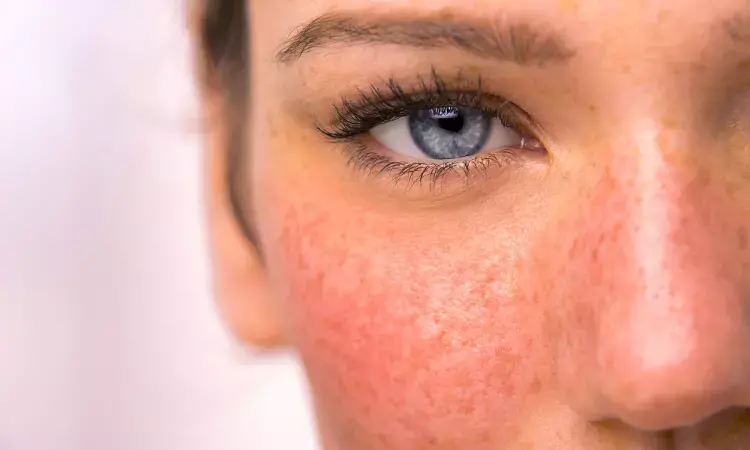- Home
- Medical news & Guidelines
- Anesthesiology
- Cardiology and CTVS
- Critical Care
- Dentistry
- Dermatology
- Diabetes and Endocrinology
- ENT
- Gastroenterology
- Medicine
- Nephrology
- Neurology
- Obstretics-Gynaecology
- Oncology
- Ophthalmology
- Orthopaedics
- Pediatrics-Neonatology
- Psychiatry
- Pulmonology
- Radiology
- Surgery
- Urology
- Laboratory Medicine
- Diet
- Nursing
- Paramedical
- Physiotherapy
- Health news
- Fact Check
- Bone Health Fact Check
- Brain Health Fact Check
- Cancer Related Fact Check
- Child Care Fact Check
- Dental and oral health fact check
- Diabetes and metabolic health fact check
- Diet and Nutrition Fact Check
- Eye and ENT Care Fact Check
- Fitness fact check
- Gut health fact check
- Heart health fact check
- Kidney health fact check
- Medical education fact check
- Men's health fact check
- Respiratory fact check
- Skin and hair care fact check
- Vaccine and Immunization fact check
- Women's health fact check
- AYUSH
- State News
- Andaman and Nicobar Islands
- Andhra Pradesh
- Arunachal Pradesh
- Assam
- Bihar
- Chandigarh
- Chattisgarh
- Dadra and Nagar Haveli
- Daman and Diu
- Delhi
- Goa
- Gujarat
- Haryana
- Himachal Pradesh
- Jammu & Kashmir
- Jharkhand
- Karnataka
- Kerala
- Ladakh
- Lakshadweep
- Madhya Pradesh
- Maharashtra
- Manipur
- Meghalaya
- Mizoram
- Nagaland
- Odisha
- Puducherry
- Punjab
- Rajasthan
- Sikkim
- Tamil Nadu
- Telangana
- Tripura
- Uttar Pradesh
- Uttrakhand
- West Bengal
- Medical Education
- Industry
Pulsed dye laser as effective as other laser therapies for managing rosacea,claims study

Laser and light-based therapies (LLBT) are adequate additions to the often symptom-oriented topical or oral therapies of rosacea. They supplement in an efficient and mostly long-lasting fashion the conservative treatment and general skin care. However, the number of well-controlled studies on efficacy, adverse events, and tolerability is very sparse. Likewise, long-term data on repeated laser procedures in rosacea are poor.
A recently published systematic review with meta-analysis has put forth that the quality of evidence to support any recommendation on LLBT in rosacea is low-to-moderate. Among all the available devices, PDL holds the most robust evidence, although in the meta-analysis the effectiveness was comparable to other LLBT, such as neodymium: yttrium-aluminum-garnet laser (Nd-YAG) or IPL.The review repots have been published in International Journal of Dermatology.
The current scenario and position of laser and light-based therapies (LLBT) in the therapeutic rosacea scheme are lacking evidence-based recommendations and comparisons on efficacy and tolerability among different devices. This article aimed to systematically compare the efficacy, acceptability, and tolerability of the pulsed dye laser (PDL) versus other devices.
For the analysis, a literature search was conducted in March 2020. Four domains were analyzed throughout the following six outcomes: Spectrophotometer erythema index and percentage of reduction for background erythema, telangiectasia grading scale for telangiectasias, visual analog scale for pain, and physician's assessment and patient's satisfaction for treatment success.
Results highlighted some key facts.
- Our search yielded 423 potentially relevant studies.
- After removing the excluded and duplicated records, 12 records were assessed for eligibility in the meta-analysis. Erythema (RR:0.38 95%CI: −0.20-0.95), telangiectasias (RR:0.54 95%CI: −0.87-1.94), and the treatment success throughout the physician's assessment (RR:1.23 95%CI: 0.74-2.04) and the patient's satisfaction (RR:1.15 95%CI: 0.73-1.82) were not significantly different between pulsed dye laser and other LLBT.
- In the pain domain, PDL was as painful as other LLBT (RR:-0.23 95%CI: −0.96-0.49) but more painful than neodymium: yttrium-aluminum-garnet laser (RR:0.84 95%CI: 0.53-1.14) and less than intense pulsed light (RR:-1.18 95%CI: −1.56−0.80).
"In the future, treatment options should be tailored for each specific clinical scenario as it is unlikely that single modality results in complete and permanent resolution. Platforms that include two or more devices and combined therapies with topical agents are suitable for this endpoint, and they warrant further investigations.
Well-designed future clinical trials to further optimize treatment parameters and comparisons and the inclusion of novel devices such as yellow laser or photodynamic therapy may change the current paradigms of LLBT in the management of rosacea."the team concluded.
For full article follow the link: https://doi.org/10.1111/ijd.15680
Dr Satabdi Saha (BDS, MDS) is a practicing pediatric dentist with a keen interest in new medical researches and updates. She has completed her BDS from North Bengal Dental College ,Darjeeling. Then she went on to secure an ALL INDIA NEET PG rank and completed her MDS from the first dental college in the country – Dr R. Ahmed Dental College and Hospital. She is currently attached to The Marwari Relief Society Hospital as a consultant along with private practice of 2 years. She has published scientific papers in national and international journals. Her strong passion of sharing knowledge with the medical fraternity has motivated her to be a part of Medical Dialogues.
Dr Kamal Kant Kohli-MBBS, DTCD- a chest specialist with more than 30 years of practice and a flair for writing clinical articles, Dr Kamal Kant Kohli joined Medical Dialogues as a Chief Editor of Medical News. Besides writing articles, as an editor, he proofreads and verifies all the medical content published on Medical Dialogues including those coming from journals, studies,medical conferences,guidelines etc. Email: drkohli@medicaldialogues.in. Contact no. 011-43720751


